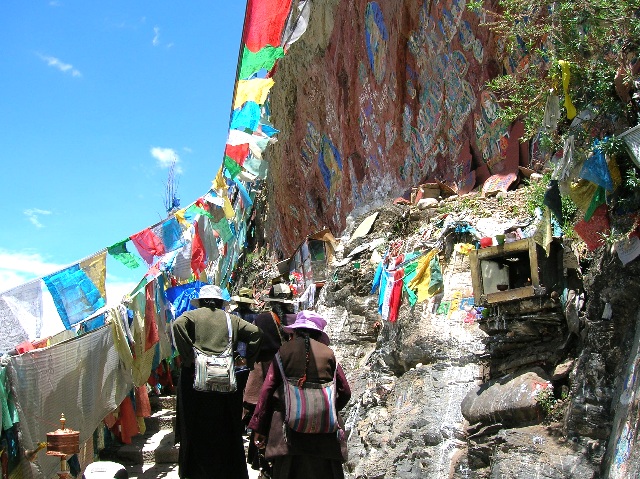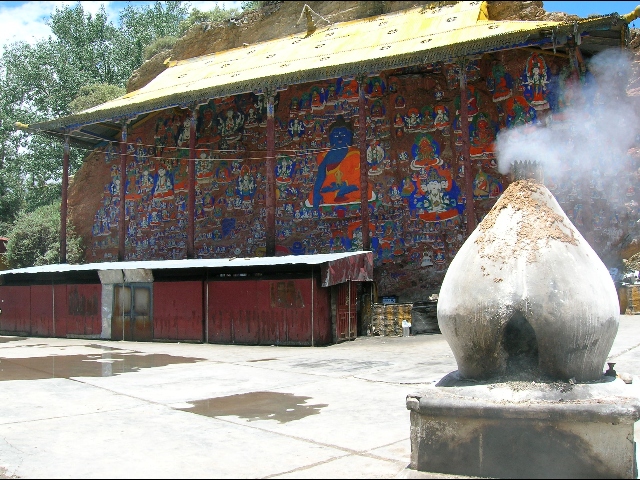| Prelude |
Day 4: Urban KoraAfter yesterday's climb I decide to take it easy. I do my usual three laps of the Jokhang temple and my prostrations, then set out for the 'Urban Kora' mentioned in my guidebook that apparently was the most sacred walk in old Lhasa.The guide mentions that some of the sacred landmarks have been replaced by secular ones, but it seems as if all of them have. For better or worse Lhasa has become a modern, vibrant, efficient, cosmopolitan city where just about anything is available if you have money, which a lot of people do. This is a kora of temptations and I fall for every single one of them. I pass clothing stores ( I buy a nice shirt), banks (I change my money), computer stores (I search in vain for accessories for my digital camera), pharmacies (I see two young female pharmacy assistants in white coats sitting outside, one on the other's lap, in the most intimate embrace: are they lesbians, bi, or just good friends bored by the absence of customers?) The first evidence of an actual sacred circuit that I see is some offering-fires as I follow the route along the river embankment. The great offering-fire mentioned in the guidebook as a landmark has been replaced by a plate-glass office building that looks like the offices of an Internet startup, and it takes me a long while to find the right turning. Finally I find the pilgims' narrow passageway,
After this brief visit to Old Tibet I head North, crossing the road from the Potala to the Norbulingka summer palace and walking along a pleasant side road of restaurants, bars, and beauty shops. From outside one of the beauty shops a woman calls out 'Hey, ma-sa-chi!' I get that she means massage: she is one of the most gorgeous women I have ever seen, with the most beautiful smile. I wonder what kind of massage she means. She is actually quite conservatively dressed by Chinese summer standards, in a light sweatshirt and knee-length skirt (the country has come a long way since Mao boiler-suits: micro-hotpants and see-through chiffon miniskirts are quite acceptable office wear now). She seems friendly but not over-friendly or seductive, and her friends standing beside her on the kerb also seem pleasant and friendly in the innocuous way that Tai Chi players in the parks are friendly to strangers. Her reaching out to me feels like more like a spontaneous impulse than a necessary part of her job. The beauty shop looks very legitimate, with hairdryers, beauty products, fashion posters, and magazines. But I am getting a very definite erotic charge, and I have no idea if it is coming from them or from me. Of course it is coming from me - who else could it be coming from? We always want to blame the banks for our cupidity, the fashion industry for our vanity, our enemies for our anger, food, alcohol and drugs for our addiction, and beautiful women for our lust. 'The woman tempted me, and I did eat', 'No really, it was all the serpent's fault' - honestly, whiners we are! Can't we ever just accept our habitual tendencies without finding someone or something else to blame for them? I am torn: I want this massage whether it is 'legitimate' or not. But I am carrying my passport and Kailas travel permit in my moneybelt, as well as my best friend and ex-wife Pamela's digital camera around my neck. I have committed too much to this pilgrimage to put it at risk now, so I give her a fluent and polite explanation in Chinese about how I am on a pilgrimage and can't spare the time. But I know I will be back and note the name of the street. To write it here would perhaps be bad karma: I am struck by the fact that it means, in an odd mixture of Chinese and Tibetan, 'The Central Highway of Light'. I will see this street again but never this woman.
Whack! Whack! Whack! In her eyes I see the conflict between the beauty I aspire to and the ugliness of what I actually do most of the time.
|


